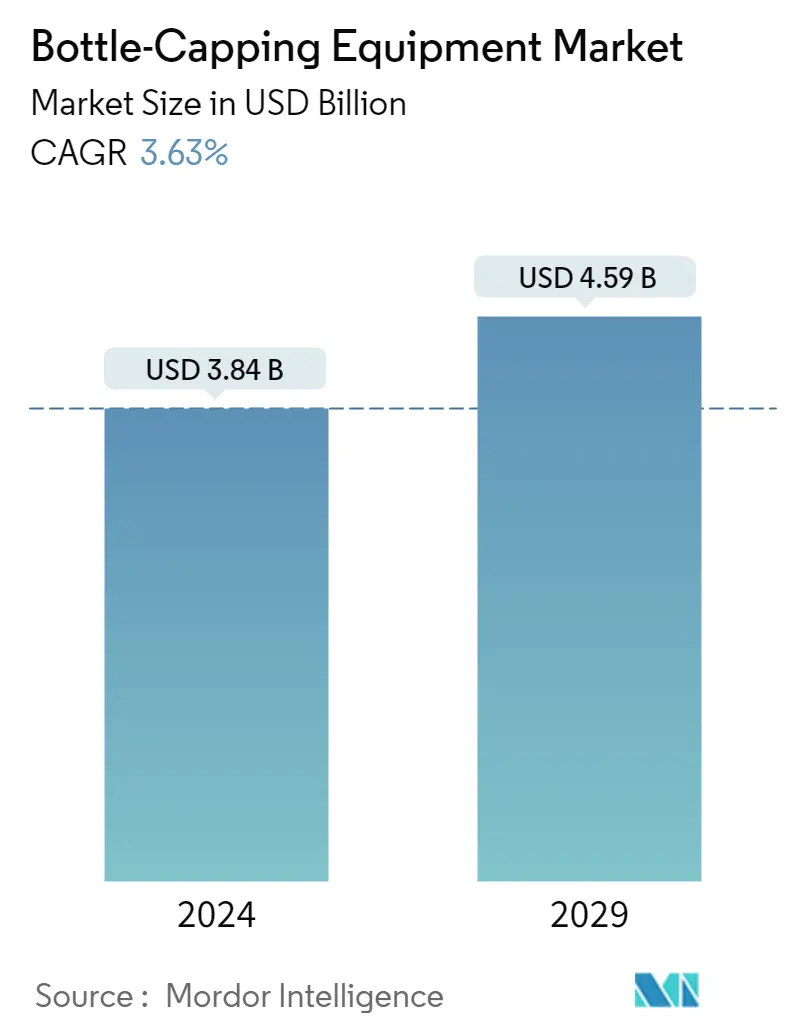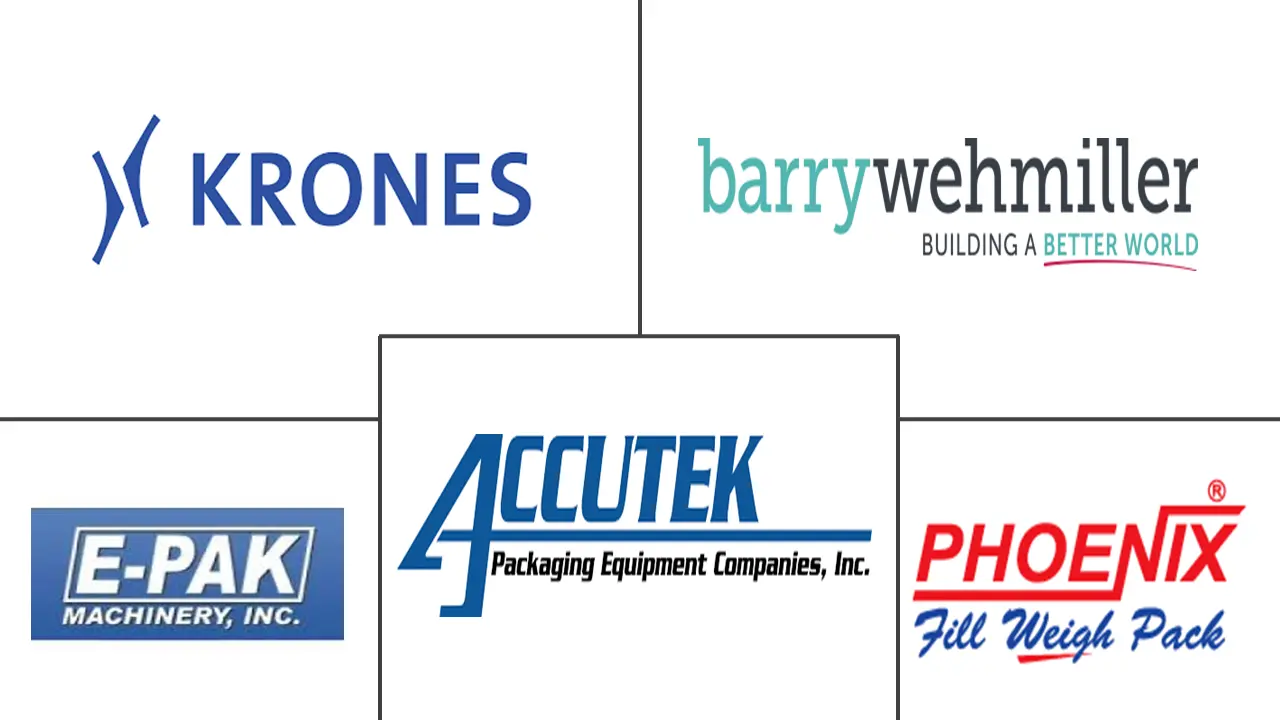Market Size of Bottle-Capping Equipment Industry

| Study Period | 2019 - 2029 |
| Market Size (2024) | USD 3.84 Billion |
| Market Size (2029) | USD 4.59 Billion |
| CAGR (2024 - 2029) | 3.63 % |
| Fastest Growing Market | Asia-Pacific |
| Largest Market | Asia-Pacific |
Major Players
*Disclaimer: Major Players sorted in no particular order |
Bottle-Capping Equipment Market Analysis
The Bottle-Capping Equipment Market size is estimated at USD 3.84 billion in 2024, and is expected to reach USD 4.59 billion by 2029, growing at a CAGR of 3.63% during the forecast period (2024-2029).
Capping machines designed for different sizes and types of bottles should be equipped with CIP (Clean-in-Place) technology to help sanitize the capping machine and avoid contamination. It is common in the food processing and pharmaceutical industries. CIP technology is fully automated, minimizing human contact, which is considered a significant source of contamination. Such technological innovations are expected to drive the market over the forecast period.
- The growing demand for fast-moving beverages and pharmaceuticals is pushing manufacturers to increase the speed of their production lines. There is a growing need for bottle capping equipment to fill the bottles quickly while maintaining volumetric and weight accuracy. The demand for bottle packaging is also increasing as consumers become more conscious of healthy and safe products.
- Capping machines are widely used to securely seal bottles throughout the packaging, mainly in the pharmaceutical and chemical industries. Capping machines enhance the manufacturing process with quality and sanitization, a few factors expected to drive the demand for capping machines.
- Capping machines are used to pack different types of bottles made of plastic, glass, or metal. In recent years, rising disposable incomes and living standards of health-conscious consumers have increased the demand for processed foods, leading to the development of the food and beverage industry. The increasing demand for packaged beverages is expected to drive the growth of the bottle-capping equipment market.
- Building a packaging industry requires significant capital investments due to high equipment costs. Therefore, the overall maintenance cost of the entire set-up is very high, which also restrains the growth of the bottle-capping equipment market.
- The pharmaceutical industry witnessed increased demand for bottle capping machines with the growing threat of the COVID-19 pandemic. It prompted companies to initiate R&D processes to develop vaccines to prevent the spread of the virus, thus aiding the market's growth.
Bottle-Capping Equipment Industry Segmentation
The study considers revenues accrued from the sales of different bottle-capping machines by various vendors operating in the market. The revenue (in USD billion) of capping machines is considered for the market size and forecasts. The report also studies the impact of COVID-19 on the bottle-capping equipment market based on the prevalent base scenarios, key themes, and end-user vertical-related demand cycles.
The bottle capping equipment market is segmented by technology (automatic, semi-automatic), cap type (ROPP caps, screw caps, snap-on-caps, corks), end user (pharmaceuticals, personal care and cosmetics, food & beverage, chemicals, automotive), and geography (North America (United States, Canada), Europe (United Kingdom, Germany, France, Rest of Europe), Asia-Pacific (China, India, Japan, Rest of Asia-Pacific), Latin America (Mexico, Brazil, Rest of Latin America), Middle East and Africa (United Arab Emirates, Saudi Arabia, Rest of Middle East and Africa). The market sizes and forecasts are provided in terms of value (USD billion) for all the above segments.
| Technology | |
| Automatic | |
| Semi-automatic |
| Cap Type | |
| ROPP Caps | |
| Screw Caps | |
| Snap-on-Caps | |
| Corks |
| End User | |
| Pharmaceuticals | |
| Personal Care and Cosmetics | |
| Food and Beverage | |
| Chemicals | |
| Automotive | |
| Other End Users |
| Geography | ||||||
| ||||||
| ||||||
| ||||||
| ||||||
|
Bottle-Capping Equipment Market Size Summary
The bottle-capping equipment market is poised for steady growth, driven by technological advancements and increasing demand across various sectors. The integration of Clean-in-Place (CIP) technology in capping machines is a significant innovation, enhancing sanitization and reducing contamination risks, particularly in the food processing and pharmaceutical industries. This automation minimizes human contact, aligning with the stringent safety standards required in these sectors. The rising demand for fast-moving consumer goods, especially beverages and pharmaceuticals, is pushing manufacturers to enhance production line speeds, thereby increasing the need for efficient bottle-capping solutions. The market is also witnessing a surge in demand for tamper-evident and child-resistant packaging, particularly in the pharmaceutical and chemical industries, where product safety and regulatory compliance are paramount.
The market landscape is characterized by intense competition, with major players like JBT Corporation, Tetra Pak International SA, and Krones AG leading the charge in offering advanced capping solutions. These companies are investing heavily in innovation and sustainability, as evidenced by recent product launches such as Sidel's 1SKIN and Tetra Pak's tethered cap-attached products. The expansion of manufacturing facilities in regions like Asia-Pacific, driven by increasing demand from the pharmaceutical, food, and dairy sectors, is further propelling market growth. However, the high capital investment and maintenance costs associated with packaging equipment pose challenges to market expansion. Despite these challenges, the market is expected to benefit from ongoing advancements in automation and sustainable packaging solutions, catering to the evolving needs of consumers and regulatory bodies worldwide.
Bottle-Capping Equipment Market Size - Table of Contents
-
1. MARKET INSIGHTS
-
1.1 Market Overview
-
1.2 Industry Eco-system Analysis
-
1.3 Industry Attractiveness - Porter's Five Forces Analysis
-
1.3.1 Bargaining Power of Suppliers
-
1.3.2 Bargaining Power of Buyers
-
1.3.3 Threat of New Entrants
-
1.3.4 Threat of Substitute Products
-
1.3.5 Intensity of Competitive Rivalry
-
-
1.4 Assessment of the Impact of COVID-19 and Ukraine-Russia War on the Industry
-
1.5 Pricing Analysis
-
1.6 Import and Export Analysis
-
1.7 Distributors and Spare Parts Providers of Bottle Capping Machines
-
1.8 After-sales Services Analysis
-
-
2. MARKET SEGMENTATION
-
2.1 Technology
-
2.1.1 Automatic
-
2.1.2 Semi-automatic
-
-
2.2 Cap Type
-
2.2.1 ROPP Caps
-
2.2.2 Screw Caps
-
2.2.3 Snap-on-Caps
-
2.2.4 Corks
-
-
2.3 End User
-
2.3.1 Pharmaceuticals
-
2.3.2 Personal Care and Cosmetics
-
2.3.3 Food and Beverage
-
2.3.4 Chemicals
-
2.3.5 Automotive
-
2.3.6 Other End Users
-
-
2.4 Geography
-
2.4.1 North America
-
2.4.1.1 United States
-
2.4.1.2 Canada
-
-
2.4.2 Europe
-
2.4.2.1 United Kingdom
-
2.4.2.2 Germany
-
2.4.2.3 France
-
2.4.2.4 Rest of Europe
-
-
2.4.3 Asia-Pacific
-
2.4.3.1 China
-
2.4.3.2 India
-
2.4.3.3 Japan
-
2.4.3.4 Rest of Asia-Pacific
-
-
2.4.4 Latin America
-
2.4.4.1 Mexico
-
2.4.4.2 Brazil
-
2.4.4.3 Rest of Latin America
-
-
2.4.5 Middle East & Africa
-
2.4.5.1 United Arab Emirates
-
2.4.5.2 Saudi Arabia
-
2.4.5.3 South Africa
-
2.4.5.4 Rest of Middle East & Africa
-
-
-
Bottle-Capping Equipment Market Size FAQs
How big is the Bottle-Capping Equipment Market?
The Bottle-Capping Equipment Market size is expected to reach USD 3.84 billion in 2024 and grow at a CAGR of 3.63% to reach USD 4.59 billion by 2029.
What is the current Bottle-Capping Equipment Market size?
In 2024, the Bottle-Capping Equipment Market size is expected to reach USD 3.84 billion.

